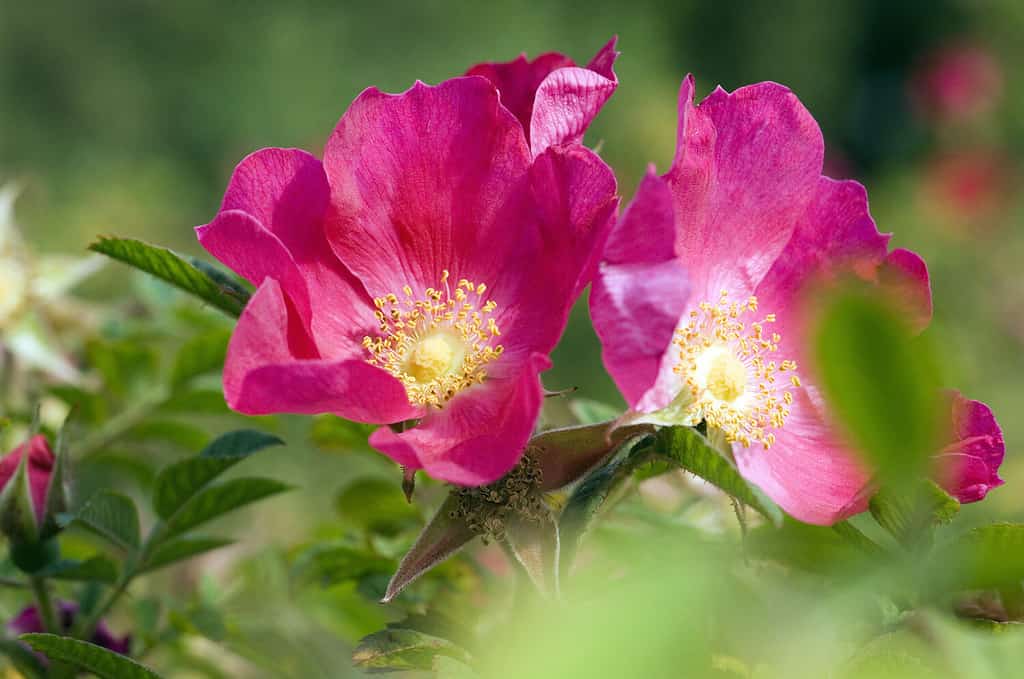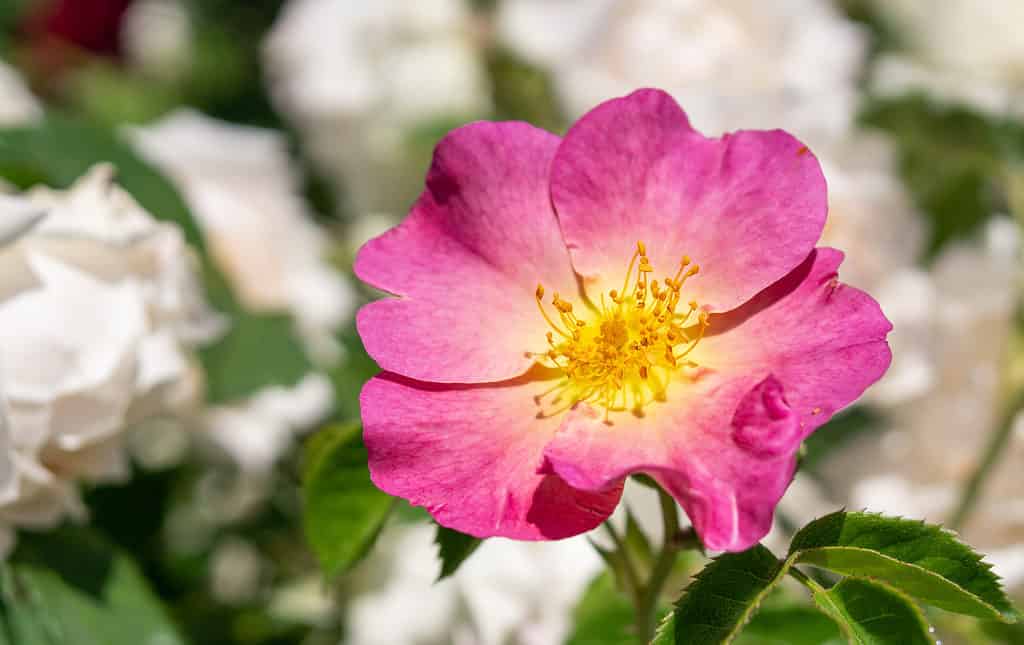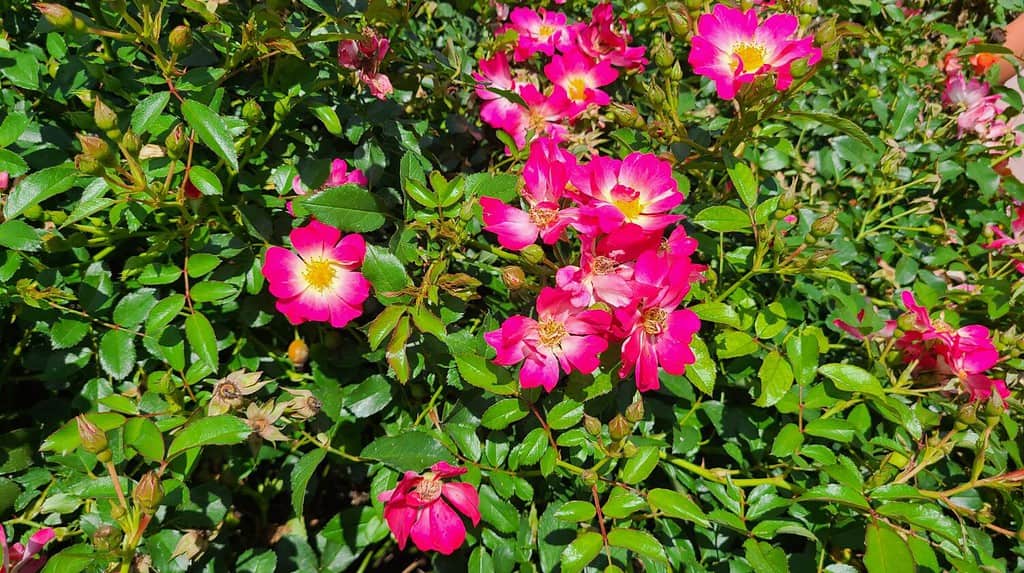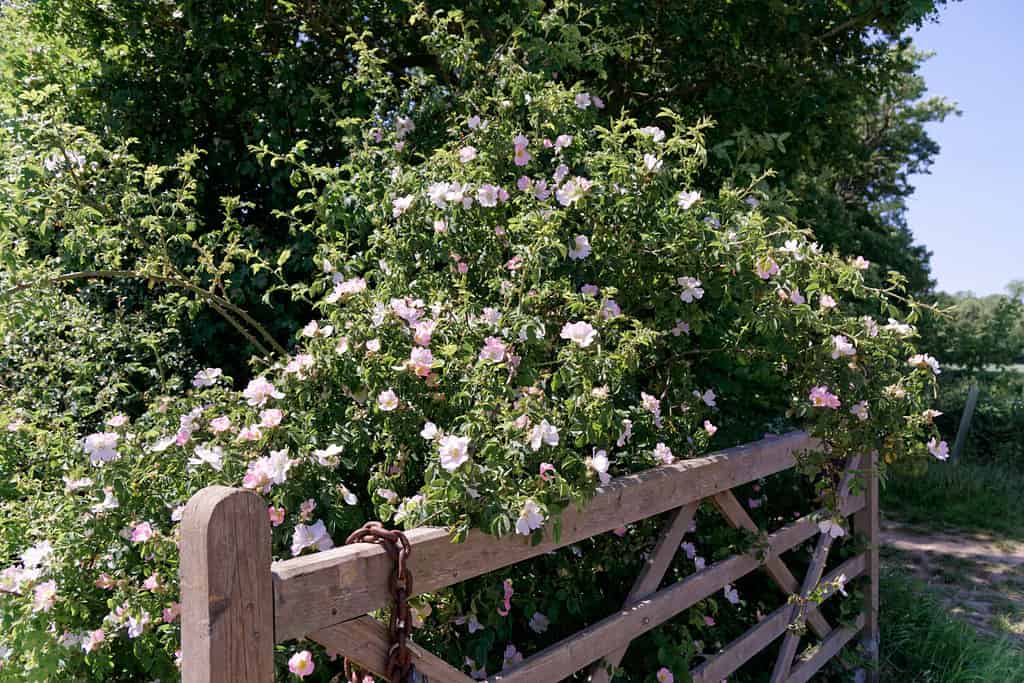Many species of wild roses call Idaho their Idahome — and with such a diversity of climate zones throughout the state, that’s probably no surprise. While there are several native species of roses in Idaho, there are also some non-native species that are found in the wild just as, if not more, frequently.
In this article, we’ll take a look at five notable species of wild roses you might encounter throughout the gem state. Whether you’re interested in planting some native roses at home in your landscape or garden or just want to better identify your local flora, the roses on our list below are worth investigating.
Native Roses in Idaho
The following three species of wild roses are native to the state of Idaho. They can be found in various environments across the state and serve important ecological roles in the habitats they grow in.
Baldhip Rose (Rosa gymnocarpa)
The baldhip rose is a long-lived wild rose that is native to both northern and central Idaho. In its natural habitat, it will often form associations with other forest understory plants like Oregon grape, huckleberry, and thimbleberry.
This species of rose produces small, light, or dark pink blooms with pale yellow stamens from May through July. Flowers are usually solitary and appear at the branch tips. The shrub itself is small for a rose, growing from 1 to 4 feet in overall height. Each of its many branches is covered in a plethora of small, needly prickles. While they may look menacing, they are often very weak. Some bushes of this species do not produce any prickles at all.
If you’re interested in planting roses in Idaho, you will want to consider this native species. Not only does it make for a wonderful garden rose but it is also a great choice for long-term recovery of disturbed environments. Because it is thicket-forming and rhizomatous, this resilient wild rose provides good cover to soil and wildlife, a plentiful summer and autumn food source, and aids in erosion control.

The rhizomatous growth of the baldhip rose is key to stabilizing eroded soils and helping wildlife recover from disturbance. This diminutive, thicket-forming plant offers not only low cover but also a continuous and resilient source of food.
©Manfred Ruckszio/Shutterstock.com
Woods’ Rose (Rosa woodsii ultramontana)
This species is the most prolific of the native roses in Idaho, having an established range that spreads much further than the state’s borders. The range of Woods’ rose spans nearly the entire continent of North America. It appears in 21 U.S. states and all but the most northern and eastern Canadian provinces.
That it does so well in Idaho’s wide range of climate zones is no surprise at all. In addition to its tolerance to both heat and cold, Woods’ rose thrives in a multitude of different habitat types. While it often takes root in forest understories, it also frequents desert grasslands, plains, prairies, and even high-altitude alpine habitats.
This species, like the baldhip rose, is a key player in the recovery of disturbed ecosystems. It is often one of the first species to appear after wildfires, river- and streambank erosion, and deep land disturbances, both natural and human-caused.
There are many subspecies of Woods’ rose that display different morphological characteristics based on the geographical region they inhabit. The one that occurs most frequently in Idaho is Rosa woodsii ultramontana. Individuals of this subspecies grow from 3 to 9 feet in height on average, producing red or grey-brown stems. Not all plants are armed, but those that produce straight prickles along the stems or at the base of the leaves. As the baldhip rose, Woods rose flowers from May through July. The beautiful, broadly-notched flowers appear in clusters of 3 to 10 and ultimately give way to red or reddish-purple, edible rosehips.

A close-up photo of Woods’ rose. These extremely hardy roses are some of the first plants to respond when environments are disturbed by fire, bank destabilization, or deep soil disruption.
©MOOKKAI/Shutterstock.com
Nootka Rose (Rosa nutkana)
The Nootka Rose, named after the indigenous peoples of the Nootka Sound, is native throughout the Pacific Northwest. While rare in southern Idaho, it occurs more commonly in the northern regions of the state.
In the wild, the Nootka rose can grow anywhere from 1 to 9 feet in height. It has slender, dark brown or black stems and may or may not have thorns depending upon the subspecies. If you want to find it in its natural environment, search in forested areas that consist of Douglas-fir, ponderosa pine, and mountain hemlock. It also associates frequently with dogwoods and quaking aspens.
The flowers of this species rose are delicate shades of pink, appearing singly at the tips of branches from May to July. Each one usually measures anywhere from 2 to 3 inches across and, if pollinated, leaves behind a supple reddish-purple rosehip at the end of the season.
The Nootka rose is known for the longevity of its rosehips. They remain firmly attached to the bush throughout the winter, thus providing valuable winter forage for birds, mammals, and insects. Elk and deer often use this species as browse throughout the warmer months and consume it occasionally during the winter.

A delicate pink Nootka rose, or
Rosa nutkanais borne atop one of the plant’s slender canes.
©ElenaGwynne/Shutterstock.com
Non-native Roses in Idaho
While the following non-native species roses are quite beautiful and provide resources for Idahoan wildlife, they often smother local plant populations. It’s worth learning how to identify these species, especially for evaluating the status of the environments you find them in. If you decide to plant these species at home, you should be aware that they very readily escape cultivation.
Sweetbriar (Rosa eglanteria syn Rosa rubiginosa)
Although not native, the common sweetbriar grows wild in Idaho. It originated in Europe, North Africa, and western Asia, escaping cultivation and becoming naturalized in North America. It is cold-hardy to USDA zone 4 and therefore grows easily as a perennial throughout most of Idaho.
Sweetbriars are popular landscape roses in Idaho and across the Pacific West, though their planting is usually discouraged. This rose species spreads rapidly with its suckers and plentiful seeds, forming dense thickets. While they are beautiful, sweetbriar often displace local plant species.
Because it is so prolific, sweetbriar can be found across a wide range of the west coast of the United States and Canada. It grows wild from British Columbia southward into California, having naturalized across the terrain west of the Cascades. If you’re looking for this species in the wild, it usually shows up along forest edges and roadsides, as well as in drainage ditches and pastures.
The small pink or white flowers, which usually bloom from June through July, dot the surface of the plant and leave behind orange or red rosehips in the fall. These fruits are edible after removing the seeds. When torn or bruised, the foliage takes on a unique apple-like scent.

Sweetbriar, though beautiful, can quickly take over a garden and the surrounding landscape without careful maintenance. Birds and mammals readily spread the seeds contained within their red fruits.
©Thomas Plante/Shutterstock.com
Dog Rose (Rosa canina)
The dog rose is another one of the non-native species of roses in Idaho. Like the sweetbriar, the dog rose originated in Eurasia and made its way to North America. Like many other escaped plant species, it escaped cultivation and has since spread far and wide.
Its pink and white, 2-inch-wide, open-faced flowers are great attractors of pollinating insects like bees and moths. While its abundant flowers, rosehips, and rambling growth provide resources to local insects, birds, and mammals, they can often cause problems for local vegetation.
This species of rose is a fast grower, spreading quickly and readily throughout a variety of soil types and conditions. Its arching stems, which produce roots when they contact with the soil, can spread up to 15 feet from the parent plant. This reproductive process, called layering, is incredibly effective. Consider this alongside the value of its fruits and seeds to foraging animals and you can imagine how easily this plant can naturalize. The dog rose is such a strong reproducer that it exists across large parts of the continent. It appears in over half of all U.S. states and throughout multiple Canadian provinces.

The dog rose,
Rosa canina. Its fast, rambling growth and high seed production enable it to form dense thickets in a short period. While this can be useful for erosion control or bank stabilization, it often quickly displaces local vegetation.
©CarlsPix/Shutterstock.com
The photo featured at the top of this post is © Iva Vagnerova/Shutterstock.com
Thank you for reading! Have some feedback for us? Contact the AZ Animals editorial team.






